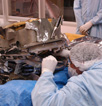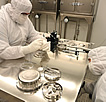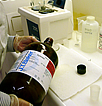The Genesis mission brought important new evidence to scientists working to understand how the solar system formed, but it also brought an unprecedented challenge. Never before did the problem of cleaning away contaminants play such a major role in the investigation of extraterrestrial samples.
| |
 |
| |
Recovery Team member analyses capsule’s condi-
tion just after land-
ing in temporary cleanroom |
When the science canister broke open in the crash landing in Utah, all of its wafers and other collection materials were exposed to a witches’ brew of contaminants: dust, soil, and brine from the wet desert floor; combustion products from the fiery plunge through the atmosphere; silicon and germanium from collectors that had smashed to dust. Making matters worse, a thin film had developed on many of the collectors, possibly the residue of a tiny amount of lubricant that vaporized in space and resettled on the wafer surfaces.
So why not just wash them off? Two factors make cleaning the samples an especially delicate matter. First, the solar wind atoms buried themselves only slightly beneath the surface of the collection wafers when they collided with the wafers out in space. Only about 100 nanometers (about 4 millionths of an inch) separate the solar wind atoms in any given collection wafer from the contaminants lying on the surface. Second, the solar wind atoms are identical to atoms found everywhere, and that includes cleaning solutions. The wrong choice of cleaning solution could add to the contamination instead of reducing it. So the Genesis team has been devoting a lot of time and effort to finding just the right way to remove the contaminants.
 |
|
On-going analyses and cataloging at JSC Curation facility |
|
“We spent the first few months parceling out samples that we thought might not be as good for science measurements,” said Genesis curator Judy Allton, “the smaller, more beat-up ones. Don Burnett and the science team were using them to try various cleaning methods to assess how clean they got the samples and whether the cleaning disturbed the solar wind atoms. We’re not going to have one standard cleaning method, because cleaning with one technique is better for some solar measurements, while other measurements require different techniques.”
“We’re going element by element and trying to solve the problems with each element,” agrees Amy Jurewicz, who is one of the chief Genesis team members working on the cleaning problem. “You can put something in an oxygen plasma and remove the brown stain (the thin film) if you’re analyzing magnesium. If you’re analyzing oxygen, you can’t do that.”
That was the problem facing Kevin McKeegan, principal investigator of the team at UCLA that was first to analyze the oxygen content of a Genesis sample. He decided to use hot xylene to clean his sample, and the curation team helped to develop a detailed procedure. “You don’t just take an irreplaceable sample and toss it under the microscope,” Allton said. “You develop special holders, you plan each step in the handling process, you write a procedure and you rehearse it and rehearse it. We spent all last summer (in 2007) developing the process for handling the target that we eventually cleaned and delivered to UCLA.”
| |
 |
| |
Members of the Genesis science team try to find the best cleaning methods so not to disturb the solar wind samples embedded in the wafers |
For certain other situations, the curation team borrowed a cleaning technique from the semiconductor industry which uses ultrapure water, and added ultrasonic vibrations at a million cycles per second. The curators use this method to clean their tools and sample containers, and they employ it on request for appropriate Genesis samples. Now, according to Allton, they’re experimenting with an additional feature. “We’ve got a new twist,” she said, “and that’s a pun.” They developed a device that holds a tiny wafer piece with suction and spins it at 3000 rpm while subjecting it to the ultrasonically excited ultrapure water. Then the water is shut off and the sample is spun dry.
The team is also experimenting with cleaning the samples for longer periods of time. “It depends on what it is,” Allton said. “The silicons can be cleaned for 5 or 10 minutes. But gold film on sapphire is cleaned for only 10 seconds because the gold gets washed away, especially if the gold film is scratched from the crash.”
Jurewicz points out that while some semiconductor techniques can be helpful, the Genesis needs are much more exacting. “There’s clean and then there’s clean,” she said. “Most semiconductor people are not worried about that very little bit of sodium you might get if your breath goes through the mask. In our case, it causes us grief.”
For some situations, the team may find it impossible to get a sample clean enough and have to find a different approach. For sodium analysis, Jurewicz said, “we may have to go in from the back (of the wafer) and not worry about any of that salt that was left on the surface from Utah.” And for some particularly vexing problems, the team may have to wait for even better instruments than the cutting-edge devices they now employ.
“Cleanliness is next to impossible,” said some anonymous wag. But the Genesis team is working on it.
~~~ |
